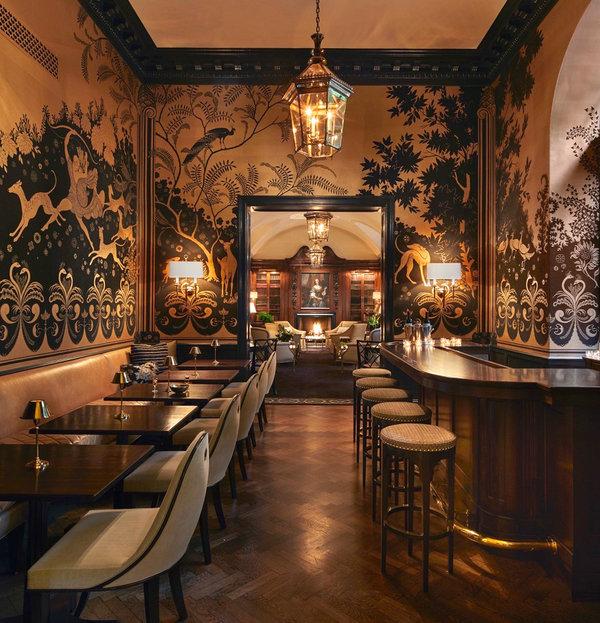If Anne Harris could be given one room in every home in the country, she would be happy. Not a seldom-used spare bedroom, either, but a room you notice. “They used to relegate me to powder rooms, children’s rooms,” Ms. Harris said, before adding with a gleam, “I want the entry hall.”
Ms. Harris, 66, is a New York-based mural artist who does richly detailed interior paintings for homes and institutions. She is the rare painter who curses the invention of the frame; her canvas is the wall, and the bigger it is, the greater the possibilities.
“I don’t know how to explain it,” she said. “But there’s a magic to doing something on the wall.”
A self-described technician, Ms. Harris shifts easily between artistic styles and periods. For a friend and client who lives in a grand apartment on Central Park West, she painted a 17th-century Dutch still life in the dining room, a sumptuous oil-paint buffet of oversized fruit and tableware. For a speakeasy in Chelsea, she covered a 19-foot-long hall in voluptuous tropical leaves. Somewhere on Fifth Avenue, there’s a snarling Tyrannosaurus rex hiding behind a bathroom door to prank guests.
“It’s the beauty of being a cousin to the art world,” Ms. Harris said of her role straddling art and interior design. “There’s a personal style in there, but I can play with simple designs or more sophisticated designs.”

Murals by Ms. Harris were recently installed in the lounge of a private women’s club in downtown Chicago.CreditWerner Straube
Joan Craig, an architect and principal at Craig & Co., has hired Ms. Harris for several projects, including an Art Deco mural for a private women’s club lounge in Chicago that won them an award from the Institute of Classical Architecture & Art.
Ms. Craig said most people needed the idea of a mural suggested to them, and even then, to be gently coaxed through its creation. “Having worked with Anne and knowing her magic, it’s not an issue for me,” she said. But clients “have to be open to a surprise. Otherwise, you might as well roll out the wallpaper.”
Connie Newberry, an interior designer in Manhattan, brought in Ms. Harris to create a serene woodland scene for a client’s entry hall on Park Avenue. It was an ideal place for a mural, she said: “This is a space you move through. You can take more of a chance in these spaces.”
Decorative painting has fallen in and out of fashion over the years. This is an art form that perhaps reached a pinnacle during the Italian Renaissance, after all. It was on a vacation to Italy in 1980 that Ms. Harris, then in her 20s and abroad for the first time, discovered the immersive beauty and nuanced colors of frescoes painted by artists like Giovanni Battista Tiepolo and Raphael.
But it wasn’t until later that decade, after working the front counter at Christie’s, for a travel publication selling ads and for Town & Country magazine, that Ms. Harris, who majored in painting in college, became a full-time artist. It coincided with a period when decorative techniques like faux marbling and glazing were the rage. She painted a lot of floors to look like inlaid wood.
“Everywhere I’d go I’d try to convince them to do a mural,” Ms. Harris said. “I’d see a room and go, ‘You know what this needs?’”
Thirty years later, having raised two children from her brush in a rent-stabilized apartment on the Upper East Side, Ms. Harris is still making the case. A mural can be a tough sell for lovers of minimalism, and a splurge. Most of her clients have decorators and live in wealthy enclaves like the Upper East Side or Greenwich, Conn.
Her murals start around $5,000, Ms. Harris said, and have cost as much as $140,000 for an elaborate Park Avenue commission — secured through the decorator Juan Pablo Molyneux — that took her a year and a half to complete working with assistants. But lately, color and pattern are back, and Ms. Harris hasn’t been this busy in 20 years, she said. (She can complete two to three entire room murals in a year, with smaller works in between; in busy periods, the waiting list gets longer.)
On a recent morning, she was in her studio in Long Island City, where, she joked, her en plein-air view was of “Freddie’s auto shop.” She was finishing two murals: a huge map of the South Carolina Low Country, inspired by the Gallery of Maps at the Vatican and destined for a house in Hilton Head, S.C., and an impressionistic scene of trees and a lake for a private restaurant in a residential building in Manhattan that Ms. Craig has been hired to freshen.
In nearly all cases, Ms. Harris paints in her studio on canvas, which she dries and varnishes before her works are installed.
“The first job I did, I was in somebody’s apartment for five months,” Ms. Harris said. “And you know, I just shouldn’t be in somebody’s apartment for five months.” (Painting on canvas also gives the work portability if the homeowners move or if a leak should spout in the apartment upstairs.)
As a mural painter, there are two things Ms. Harris wishes above all. The first is that she be brought in during the initial conception of a space (she’s often summoned later). And second, that everyone, everywhere, see decorative murals for the incredible and flexible art form they are.
To that end, Ms. Harris said she was trying to be more minimal “because I think you can do really simple, elegant things that wouldn’t cost very much and yet are part of the room.”
She added: “A frame painting, it’s fine. But my heart is in surrounding someone. Because it transports you.”







